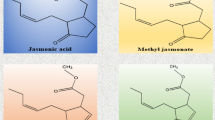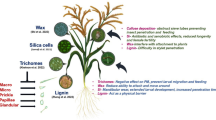Abstract
Wounding increases the levels and activities of several defense-related proteins in the foliage of the tomato plant,Lycopersicon esculentum Mill. Evidence indicates that two of these responses, the systemic increases in polyphenol oxidase and proteinase inhibitors, are regulated by an octadecanoid-based signalling pathway which includes the wound hormone, jasmonic acid. It is not known whether other responses to wounding are also regulated by this same signalling pathway. In this paper, we show that application of jasmonates (jasmonic acid or its volatile derivative, methyl jasmonate) in low concentrations to foliage of young tomato plants induced, in a dose-dependent manner, the same protein responses-polyphenol oxidase, proteinase inhibitors, lipoxygenase, and peroxidase-as doesHelicoverpa zea Boddie feeding. Application of jasmonic acid to a single leaflet of four-leaf tomato plants induced these four proteins in a spatial pattern nearly identical to that produced by localized feeding ofH. zea. Exogenous jasmonic acid also decreased suitability of foliage for the beet armyworm,Spodoptera exigua Hubner in the laboratory. Based on these results, we conducted an experiment to measure the effects of jasmonic acid spray under field conditions. We provide the first evidence that jasmonic acid spray on field plants induces production of chemical defenses above the levels found in unsprayed controls. Exogenous jasmonic acid sprayed on plants in agricultural plots increased levels of polyphenol oxidase and proteinase inhibitors. Because application of jasmonic acid induces these defensive compounds at low concentrations in a manner similar to natural wounding, it may prove to be a useful tool for stimulating plant resistance to insects in the field.
Similar content being viewed by others
References
Baldwin, J. T. 1994. Chemical changes rapidly induced by folivory, pp. 1–23,in E. A. Bernays (ed.). Insect-Plant Interactions, Vol. V. CRC Press, Boca Raton.
Bronner, R., Westphal, E., andDreger, F. 1991. Enhanced peroxidase activity associated with the hypersensitive response ofSolanum dulcamara to the gall miteAceria cladophthirus (Acari: Eriophyoidea).Can. J. Bot. 69:2192–2196.
Constabel, C. P., Bergey, D. R., andRyan, C. A. 1995. Systemin activates synthesis of wound-inducible tomato leaf polyphenol oxidase via the octadecanoid defense signalling pathway.Proc. Natl. Acad. Sci. 92:407–411.
Creelman, R. A., Tierney, M. L., andMullet, J. E. 1992. Jasmonic acid/methyl jasmonate accumulate in wounded soybean hypocotyls and modulate wound gene expression.Proc. Nat'l. Acad. Sci. 89:4938–4941.
Doares, S. H., Syrovets, T., Weiler, E. W., andRyan, C. A. 1995. Oligogalacturonides and chitosan activate plant defensive genes through the octadecanoid pathway.Proc. Nat'l. Acad. Sci. 92:4095–4098.
Duffey, S. S., andFelton, G. W. 1991. Enzymatic antinutritive defenses of the tomato plant against insects. pp. 167–197.in P. A. Hedin (ed.). Naturally Occurring Pest Bioregulators. ACS Symposium Series 449. Dallas, Fall 1989. American Chemical Society, Washington, D.C.
Farmer, E. E., Johnson, R. R., andRyan, C. A. 1992. Regulation of expression of proteinase inhibitor genes by methyl jasmonate and jasmonic acid.Plant Physiol. 98:995–1002.
Farmer, E. E., andRyan, C. A. 1992. Octadecanoid precursors of jasmonic acid activate the synthesis of wound-inducible proteinase inhibitors.Plant Cell 4:129–134.
Hildebrand, D. F., andHymowitz, T. 1981. Two soybean genotypes lacking lipoxygenase-1.J. Am. Oil Chem. Soc. 58:583–586.
Karban, R., andBaldwin, I. T. 1997. Induced responses to herbivory. University of Chicago Press. Chicago, in press.
Karban, R., andMyers, J. H. 1989. Induced plant responses to herbivory.Annu. Rev. Evol. Syst. 20:331–48.
Kessmann, H., Staub, T., Hofmann, C., Maetzke, T., Herzog, J., Ward, E., Uknes, S., andRyals, J. 1994. Induction of systemic acquired disease resistance in plants by chemicals.Annu. Rev. Phytopathol. 32:439–459.
Kogan, M., andPaxton, J. 1983. Natural inducers of plant resistance to insects,in Plant Resistance to Insects. P. A. Hedin (ed.). American Chemical Society Symposium Series 208. Washington, D.C.
Marangoni, A. G., Brown, E. D., Stanley, D. W., andYada, R. Y. 1989. Tomato peroxidase: Rapid isolation and partial characterization.J. of Food Science 54:1269–1271.
Reinbothe, S., Mollenhauer B., andReinbothe, C. 1994. JIPs and RIPs: The regulation of plant gene expression by jasmonates in response to environmental cues and pathogens.Plant Cell 6:1197–1209.
Stout, M. J., andDuffey, S. S. 1996. Characterization of induced resistance in tomato plants.Entomol. Exp. Appl. 79:273–283.
Stout, M. J., Workman, K. V., andDuffey, S. S. 1996. Identity, spatiality and variability of induced chemical responses in tomato plants.Entomol. Exp. Appl. 79:255–271.
Waldbauer, G. B. 1968. The consumption and utilization of food by insects.Advances in Insect Physiology 5:229–289.
Zamora, R., Olias J. M., andMesias, J. L. 1987. Purification and characterization of tomato lipoxygenase.Phytochemistry: 26:345–347.
Author information
Authors and Affiliations
Rights and permissions
About this article
Cite this article
Thaler, J.S., Stout, M.J., Karban, R. et al. Exogenous jasmonates simulate insect wounding in tomato plants (Lycopersicon esculentum) in the laboratory and field. J Chem Ecol 22, 1767–1781 (1996). https://doi.org/10.1007/BF02028503
Received:
Accepted:
Issue Date:
DOI: https://doi.org/10.1007/BF02028503




